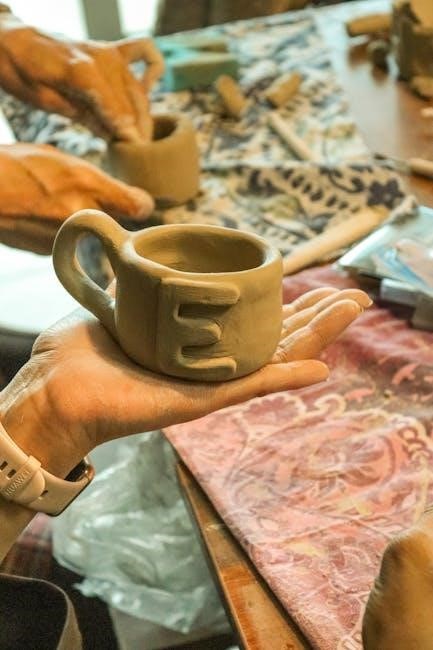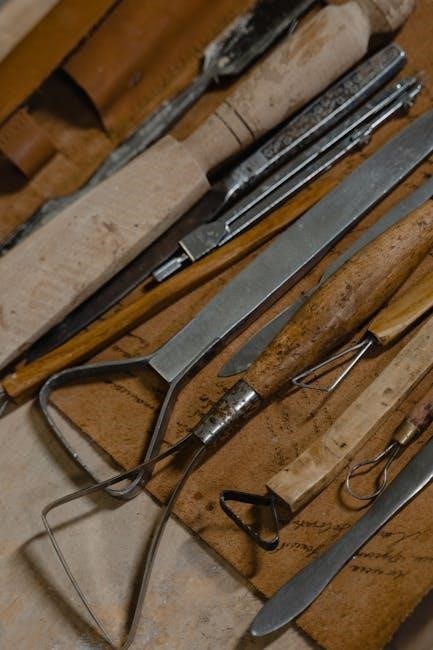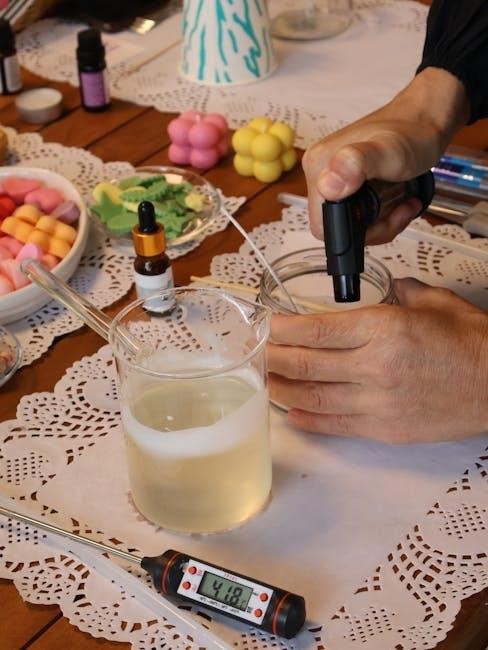The Ditto Looper is a revolutionary pedal offering studio-quality sound and simplicity, ideal for musicians of all levels. Its intuitive design makes it accessible while delivering professional-grade looping capabilities, perfect for live performances and studio use. With a focus on ease of use and affordability, the Ditto Looper has become a favorite among guitarists and vocalists seeking to enhance their creative process. This manual provides a comprehensive guide to unlocking its full potential, ensuring users can harness its features effortlessly.
1.1 Overview of the Ditto Looper
The Ditto Looper, developed by TC Electronic, is a compact and user-friendly pedal designed for creating and managing audio loops. Known for its studio-quality sound and intuitive controls, it is a favorite among guitarists and vocalists. The pedal offers a straightforward interface with essential features like loop recording, playback, and overdubbing. Its compact design makes it ideal for live performances and studio sessions. The Ditto Looper is available in various models, including the Ditto Stereo Looper and Ditto X2, each offering enhanced functionalities. This manual provides a detailed guide to understanding and utilizing the pedal’s capabilities, ensuring users can explore endless creative possibilities. Whether you’re a beginner or an experienced musician, the Ditto Looper is a versatile tool to elevate your music-making process.
1.2 History and Evolution of the Ditto Looper
The Ditto Looper, introduced by TC Electronic, marked a significant leap in loop pedal technology upon its release. Initially designed as a compact, single-button looper, it quickly gained popularity for its simplicity and high-quality audio. Over time, TC Electronic expanded the Ditto series, introducing models like the Ditto Stereo Looper and Ditto X2, which added stereo capabilities and advanced features. The Ditto 2, released as a successor, offered improved functionality while maintaining the original’s charm. Each iteration has incorporated user feedback, ensuring the pedal remains relevant and innovative. This evolution reflects TC Electronic’s commitment to delivering accessible, professional-grade tools for musicians. The Ditto Looper’s journey from a basic loop pedal to a feature-rich device underscores its impact on the music industry and its enduring popularity among artists worldwide.
1.3 Target Audience for the Ditto Looper Manual
The Ditto Looper Manual is designed for musicians, producers, and sound engineers seeking to master the pedal’s looping capabilities. It caters to guitarists, vocalists, and instrumentalists of all skill levels, from beginners exploring looping for the first time to seasoned professionals looking to expand their creative possibilities. The manual is particularly useful for live performers needing reliable, intuitive looping tools and studio artists aiming to incorporate layered sounds into their recordings. Additionally, educators and students will find the guide invaluable for understanding the fundamentals of looping technology. Whether you’re looking to enhance your performances or explore new sonic territories, this manual provides the essential knowledge to maximize the Ditto Looper’s potential. Its clear instructions ensure that every user, regardless of experience, can navigate the pedal’s features with confidence and creativity.

Key Features of the Ditto Looper
The Ditto Looper offers unlimited loops, 5 minutes of recording time, true bypass, and analog dry-through, ensuring high-quality sound and seamless performance for musicians and producers.
2.1 Hardware Components and Controls
The Ditto Looper features a robust, compact design with durable hardware components. The pedal includes a single footswitch for recording, playing, and stopping loops. A dedicated Level knob adjusts the volume of your loops, while the Loop Level knob fine-tunes the balance between the dry signal and the loop. The USB port allows for firmware updates and connectivity to a computer. A bright LED indicator provides visual feedback for recording, playback, and overdub modes. Stereo input and output jacks ensure high-quality audio processing, and the pedal is powered by an external 9V DC adapter. The hardware is built to withstand rigorous use, making it ideal for both studio and live performances. The intuitive layout ensures easy access to all controls, enabling musicians to focus on their creativity without unnecessary complexity.
2.2 Software and Firmware Capabilities
The Ditto Looper is supported by robust software and firmware capabilities that enhance its functionality. Regular firmware updates from TC Electronic ensure the pedal stays up-to-date with new features and improvements. These updates can be easily installed via a USB connection to a computer, allowing users to access the latest enhancements. The pedal’s firmware supports stereo phrase looping, enabling high-quality audio reproduction. It also allows for unlimited overdubs, giving musicians the freedom to layer sounds creatively. Additionally, the firmware includes essential functions like loop synchronization and seamless integration with other audio devices. The software capabilities are designed to complement the hardware, offering intuitive loop management and editing options. These features make the Ditto Looper a versatile tool for both live performances and studio recordings, ensuring optimal performance and reliability.
2.3 User-Friendly Interface Design
The Ditto Looper is renowned for its intuitive and user-friendly interface design, making it accessible to musicians of all skill levels. The pedal features a single-loop control layout with minimal buttons and knobs, ensuring a straightforward operation. The primary control is a large, sturdy footswitch that handles recording, playback, and loop deletion. A dedicated knob allows for easy adjustment of loop volume, while LED indicators provide clear visual feedback on loop status, playback, and memory usage. The interface is designed to minimize clutter, with a focus on essential functions that prioritize ease of use. This simplistic approach ensures that even first-time users can quickly grasp the pedal’s functionality. The compact, durable design also makes it ideal for gigging musicians, as it withstands heavy use while maintaining reliability. Overall, the Ditto Looper’s interface strikes a perfect balance between simplicity and functionality.

Getting Started with the Ditto Looper
Begin your musical journey effortlessly with the Ditto Looper. This section guides you through initial setup and basic functionality, ensuring a smooth start to creating and managing loops with confidence.
3.1 Unboxing and Initial Setup
When you unbox the Ditto Looper, you’ll find the pedal itself, a power supply, and a quick-start guide. Begin by inspecting the unit for any damage. Next, locate a suitable power source and connect the pedal using the provided adapter. Ensure the pedal is placed on a flat, stable surface. Connect your instrument using a standard guitar cable, plugging into the input jack. Turn on the pedal and familiarize yourself with the LED indicator, which signals power and recording status. If using an external power source, ensure it meets the pedal’s voltage requirements. Finally, review the quick-start guide to understand basic functions before diving into more advanced features. This setup process ensures you’re ready to start looping right away. The compact design and straightforward layout make initial setup intuitive, even for newcomers.
3.2 Basic Controls and Functions
The Ditto Looper features an intuitive design with essential controls for easy operation. The primary footswitch allows you to record, play, and stop loops with a single press. A bright LED indicator provides visual feedback, showing when the pedal is recording, playing, or in overdub mode. The Loop Level knob adjusts the volume of the loop relative to your live sound, ensuring a balanced mix. The input and output jacks are clearly labeled, making it simple to connect your instrument and amplifier. With these basic controls, you can create and manage loops effortlessly. The simplicity of the Ditto Looper makes it accessible to musicians of all skill levels, allowing you to focus on your performance without unnecessary complexity. This straightforward design ensures a seamless experience, whether you’re practicing or performing live.
3.3 Creating and Storing Your First Loop
Creating your first loop with the Ditto Looper is straightforward. Press the footswitch once to begin recording, and the LED will turn red to indicate recording is active. Play your instrument to capture the desired riff or phrase. When you’re ready, press the footswitch again to stop recording. The LED will switch to green, signaling that the loop is now playing. To overdub, press the footswitch once more to add layers to your loop. When satisfied, press and hold the footswitch until the LED flashes to store the loop. The Ditto Looper allows you to save your loops even after powering off, ensuring your creativity is preserved. Experiment with layering sounds and adjusting the Loop Level knob for the perfect balance. This feature makes it easy to build and store loops, enhancing your musical creativity and performance.

Advanced Features and Techniques
Explore advanced looping techniques with unlimited layering, seamless overdubbing, and real-time effects editing. Sync your loops with external devices for dynamic live performances and expand your creative possibilities.
4.1 Loop Layers and Overdubs
The Ditto Looper excels in creating intricate soundscapes with its limitless loop layers and overduBs. Artists can build upon their initial recordings by adding multiple layers, each enhancing the overall texture. Overdubbing allows for infinite creativity, letting musicians experiment with harmonies, rhythms, or melodic variations seamlessly integrated into the loop. The pedal ensures synchronized playback of all layers, maintaining clarity even with complex compositions. This feature is ideal for both live performances and studio work, offering flexibility and depth to musical arrangements. By strategically using loop layers and overduBs, users can craft dynamic, multi-dimensional sounds that captivate audiences. The Ditto Looper’s intuitive design makes it easy to manage and adjust these layers, ensuring a smooth and engaging creative process for all musicians.

4.2 Using Effects and Editing Loops
The Ditto Looper offers a range of effects and editing tools to refine your loops. With the ability to reverse or half-speed your loops, you can create unique and captivating soundscapes. The pedal also allows for seamless editing, such as adjusting loop endpoints or tweaking levels for perfect balance. Undo/redo functionality ensures you can experiment without losing your original ideas. These features empower musicians to transform simple loops into intricate compositions. The intuitive design makes it easy to access these tools, allowing for real-time adjustments during performances. Whether you’re layering harmonies or fine-tuning rhythms, the Ditto Looper’s effects and editing capabilities provide endless possibilities for creativity and precision.
4.3 Syncing Loops with Other Devices
Syncing loops with other devices is a powerful feature of the Ditto Looper, allowing seamless integration with drum machines, synthesizers, or other MIDI-compatible gear. The pedal supports MIDI clock synchronization, ensuring your loops stay perfectly in time with external devices. To sync, connect the MIDI IN/OUT ports to your equipment and select the appropriate sync mode in the settings menu. The Ditto Looper can function as a master or slave device, giving you flexibility in your setup. Once synced, your loops will align with the tempo of connected devices, enabling precise live performances and studio recordings. This feature is especially useful for musicians who incorporate multiple instruments or backing tracks into their workflow. By syncing your loops, you can create a cohesive and professional sound, enhancing your overall creative process and performance capabilities. This functionality makes the Ditto Looper a versatile tool for both solo artists and band setups.

Maintenance and Troubleshooting
Regular maintenance ensures optimal performance. Clean the pedal with a soft cloth, avoid harsh chemicals, and store it in a dry environment. For troubleshooting, check connections, update firmware, and reset settings if issues arise.
5.1 Cleaning and Care Tips
Proper cleaning and care are essential to maintain the Ditto Looper’s performance and longevity. Use a soft, dry cloth to wipe the pedal’s exterior, removing dirt and fingerprints. For stubborn marks, dampen the cloth slightly but ensure it’s not soaking wet. Avoid harsh chemicals or abrasive cleaners, as they can damage the finish or harm electronic components.
The footswitch should be cleaned with a dry cloth to prevent moisture from seeping into the mechanism. For the USB port, gently use a dry cotton swab to remove dust or debris. Never submerge the pedal in water or expose it to extreme temperatures. Store the Ditto Looper in a dry, cool place when not in use, and consider using a protective case during transport to prevent scratches. Regular cleaning prevents dust buildup and ensures smooth operation. By following these care tips, you can keep your Ditto Looper in pristine condition and maintain its reliability for years to come.
5.2 Common Issues and Solutions
While the Ditto Looper is a robust device, users may encounter occasional issues. One common problem is the pedal becoming unresponsive, which can often be resolved by restarting the device or updating the firmware. If loops fail to play back correctly, ensure the input levels are properly adjusted, as overly high or low levels can cause playback issues.
Another issue is the footswitch not registering presses, which may be due to dirt or debris. Cleaning the footswitch with a dry cloth can resolve this. Additionally, if the pedal produces noise or hum, check the power supply and ensure it is connected to a clean power source. Ground hum can sometimes be addressed by using a high-quality power supply or isolating the pedal from other noisy gear.
For loops that suddenly stop or disappear, reset the pedal to its factory settings. Note that this will erase stored loops, so back up your loops beforehand. These solutions address the most frequent challenges users face, helping to maintain smooth operation.
5.3 Updating Firmware for Optimal Performance
Updating the firmware on your Ditto Looper is essential to ensure optimal performance, access new features, and fix potential bugs. Begin by connecting the pedal to your computer using a USB cable. Visit the official TC Electronic website to download the latest firmware version compatible with your device. Before proceeding, backup your loops to prevent data loss during the update.
Once downloaded, follow the on-screen instructions to initiate the update process. Ensure the pedal is in firmware update mode, typically achieved by pressing and holding specific buttons while connecting the USB cable. Avoid interrupting the update process, as this could result in malfunction. After completion, restart the pedal to apply the changes.
Regular firmware updates ensure your Ditto Looper operates smoothly and maintains its functionality. Always refer to the official TC Electronic support page for detailed instructions and troubleshooting guides to handle any issues during the update process. This ensures your device remains up-to-date and performs at its best.

Accessories and Additional Equipment
The Ditto Looper comes with essential accessories like a USB cable and power supply. Optional add-ons include an external footswitch for hands-free control and a carrying case for protection during transport.
6.1 Included Accessories
The Ditto Looper typically comes with a USB cable for firmware updates and a power supply to ensure reliable operation. Additionally, TC Electronic often includes a quick start guide to help users navigate the pedal’s basic functions. These accessories provide everything needed to get started with looping right out of the box. The USB cable allows for easy connection to a computer, enabling users to download the latest firmware updates and enhance the pedal’s capabilities. The power supply ensures consistent power delivery, preventing any performance issues during gigs or practice sessions. The quick start guide is designed to be user-friendly, offering clear instructions for setting up and operating the Ditto Looper. These included accessories emphasize TC Electronic’s commitment to providing a seamless and convenient experience for musicians of all skill levels.
6;2 Optional Add-Ons for Enhanced Functionality

For musicians seeking to expand the capabilities of their Ditto Looper, several optional add-ons are available. A dedicated footswitch is a popular choice, enabling hands-free control over loop playback, stopping, and layering. This is particularly useful for live performances. Additionally, users can integrate external effects pedals to process loops in real-time, adding texture and depth to their sound. An expression pedal can also be connected, allowing for dynamic control over loop parameters such as volume or effects levels. Furthermore, external storage devices can be used to back up and organize loops, ensuring that creations are safely archived. For those who prefer a cleaner setup, a high-quality power supply or isolated power brick can be added to minimize noise and interference. These optional add-ons cater to diverse musical needs, offering enhanced creativity and efficiency for both studio and stage use.
6.3 Powering the Pedal
The Ditto Looper is designed to operate with a standard 9V DC power supply, which is typically included with the pedal. For optimal performance, use the provided adapter or a high-quality equivalent that meets the specifications (9V DC, center-negative). Avoid using adapters with incorrect voltage or polarity, as this could damage the unit. If you plan to use the pedal in a pedalboard setup, consider an isolated power brick or a multi-output power supply to minimize noise and interference. Always ensure the power source is stable and clean to maintain the pedal’s functionality. For musicians on the go, third-party battery-powered solutions are available, though they are not a standard feature. Proper powering ensures reliable operation and preserves the integrity of your loops. Regularly check the power cable and adapter for any signs of wear to prevent unexpected issues during use.

Community and Resources
Explore the vibrant TC Electronic Ditto Looper community and access extensive resources. Find official support, online forums, video tutorials, and detailed user guides to enhance your looping experience.
7.1 Online Forums and User Communities

The Ditto Looper has a thriving online community, with numerous forums and groups dedicated to sharing knowledge, tips, and experiences. Platforms like Reddit, Facebook groups, and specialized music gear forums are hubs for musicians and producers. These spaces allow users to ask questions, share techniques, and showcase their creative use of the pedal. Many enthusiasts post detailed guides, patches, and even live performances, fostering collaboration and inspiration. Experienced users often provide troubleshooting advice and insights, while newcomers can learn from the collective expertise. These communities are invaluable for staying updated on the latest features, mods, and best practices. Engaging with these forums not only enhances your understanding of the Ditto Looper but also connects you with like-minded artists. Whether you’re a beginner or an advanced user, these online communities offer endless opportunities to grow and innovate with your looping journey.
7.2 Official TC Electronic Support
TC Electronic provides comprehensive support for the Ditto Looper, ensuring users can maximize its potential. The official website offers a wealth of resources, including detailed manuals, firmware updates, and FAQs. These materials are designed to address common questions and technical queries. Additionally, TC Electronic’s customer support team is readily available to assist with troubleshooting, functionality, or compatibility issues. Users can contact the support team via email, phone, or live chat, depending on their region. The company also maintains a dedicated support page for the Ditto Looper, where you can find direct links to downloads, troubleshooting guides, and user forums. This official support ensures that users receive accurate and reliable information, helping them resolve issues quickly and efficiently. By leveraging these resources, Ditto Looper owners can enjoy optimal performance and unlock the full capabilities of their pedal.
7.3 Video Tutorials and Guides
Video tutorials and guides are an invaluable resource for mastering the Ditto Looper. Platforms like YouTube and TC Electronic’s official channel offer a wide range of instructional videos. These tutorials cover everything from basic functionality to advanced looping techniques. Many videos are created by experienced musicians and producers, providing practical insights and real-world applications. Topics include setting up the pedal, creating intricate loops, and integrating the Ditto Looper into live performances. Additionally, websites like GuitarWorld and MusicRadar often feature step-by-step guides and gear demos. These resources are particularly useful for visual learners, as they demonstrate how to navigate the pedal’s interface and utilize its features effectively. Whether you’re a beginner or an advanced user, video tutorials offer a hands-on approach to unlocking the Ditto Looper’s full potential. They also help users stay updated with the latest firmware and techniques.